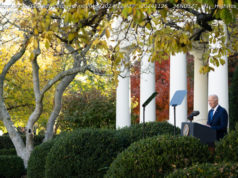The interview just raises more questions.
Rudy Giuliani’s freewheeling interviews to Fox News and other media outlets this week have cleared up some details regarding Stormy Daniels’s hush money but have left other details, and a host of legal questions, still unanswered. Yet it seems that both Trump and Cohen remain in some legal jeopardy — either for possibly violating campaign finance laws or for other disclosure violations.
The facts are these: On October 27,2016, Michael Cohen paid Stormy Daniels $130,000, through Daniels’s lawyer Keith Davidson, so she wouldn’t come forward about an alleged sexual encounter with Trump. This occurred 12 days before the presidential election, while Trump was being besieged by a series of sexual harassment accusations from many different women.
Trump later repaid Cohen this money, plus extra, Giuliani revealed Wednesday night. Giuliani told the New York Times that the repayment happened over several months in 2017, with Trump sending Cohen $35,000 each month from “his personal family account,” eventually totaling at least $460,000.
Per Giuliani, the money covered the Daniels payment and taxes that would be associated with it, as well as unspecified “incidental expenses.” (Trump himself confirmed this general story on Twitter Thursday morning .)
It’s not clear, though, just how large the Daniels payment in particular looms in either Trump’s or Cohen’s legal woes. For Trump, it’s being handled separately from Robert Mueller’s Russian election interference probe, and for Cohen, there are signs that the feds have a much broader interest in him and his finances — most recently, the report that federal investigators tapped his phones.
If this payment was made to help Trump’s prospects in the presidential election, it would seem to be obviously illegal — it would be an in-kind campaign donation that wasn’t reported at the time in required campaign financial disclosures. If Trump or his campaign knew about it, they should have disclosed it. If Cohen didn’t tell Trump or anyone on the campaign about it, then he should have disclosed it. Either way, there’s a problem.
Depending on the specifics of how the payment happened and who knew about it, there could be other legal problems too.
1) If Cohen decided to do this entirely on his own, without any understanding he’d be repaid by Trump, he blatantly violated the limit on how much a person can donate to any one campaign — because that was capped at $2,700, and his payment was $130,000.
Despite Giuliani’s revelation that Trump paid Cohen back eventually, it is still possible that at the time Cohen made the payment, he had not received any such assurances of repayment from Trump. That would, it seems, put him in violation of these limits on “in-kind” contributions to a campaign.
2) If the money ultimately came from Trump, that contribution limit wouldn’t be a problem because the candidate is permitted to spend unlimited amounts supporting his own campaign. However, that would put Trump in more legal jeopardy for not reporting the spending at the time.
So the question of when, exactly, Trump found out about it is important here. Giuliani has said Trump “wasn’t told” before the election, but added some wiggle room by saying that “even if he was told, he wouldn’t have remembered it.”
3) If Trump’s business was involved, it could be on the hook for corporate campaign spending violations, too. Cohen was, after all, an employee of the Trump Organization at the time, and he used his Trump Organization email address to discuss the payments.
The campaign finance law issues look so thorny that Trump’s team hopes to avoid them altogether, by simply asserting that Cohen’s payment to Daniels had nothing to do with the campaign.
“That money was not campaign money,” Giuliani said on Fox News Wednesday night. And the president tweeted Thursday morning that his eventual repayments to Cohen took the form of a “monthly retainer, not from the campaign and having nothing to do with the campaign.” He added, “Money from the campaign, or campaign contributions, played no roll [sic] in this transaction.”
Campaign finance law experts have generally been skeptical that this argument will work because Cohen made the payment so close to the election, when Trump’s interactions with women were a major topic of news.
Even Giuliani himself veered off message Thursday morning, saying on Fox, “Imagine if that [Stormy Daniels’s story] came out on October 15,2016, in the middle of the, you know, last debate with Hillary Clinton.” He added, “Cohen didn’t ask. He made it go away.”
Still, if we just put the campaign finance law issues to the side and just assume that prosecutors buy the Trump team’s argument here… there are still other problems.
1) Trump’s financial disclosures: If Trump understood Cohen’s $130,000 payment to Daniels as a loan that he intended to repay, it seems that he should have mentioned it on the personal financial disclosure form he filed last year. The watchdog group Citizens for Responsibility and Ethics in Washington is filing a new complaint on the matter.
2) Cohen’s home equity loan: Cohen has said he got the $130,000 in the first place by taking out a home equity credit line from First Republic Bank. The Wall Street Journal has reported that “investigators are examining whether Mr. Cohen fraudulently used a bank loan for something other than the purpose he described on his loan application.”
3) Where did the repayment money Trump used come from? Finally, Trump is claiming that he repaid Cohen purely out of his own pocket. Perhaps that is true. But there have long been questions about just where that money came from — and depending on the answer (Trump’s business? The campaign? Other people?), even deeper legal jeopardy could ensue.






